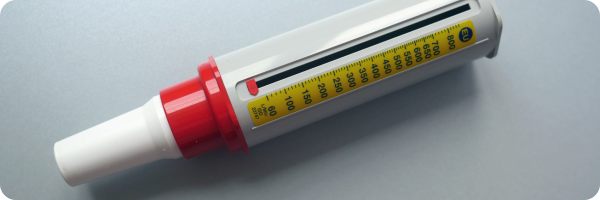When you live with asthma, COPD or both, symptoms can sometimes sneak up on you. But the earlier you spot changes – and act – the better you can protect your lungs, avoid flare-ups, and stay well.
This article will help you understand what to watch out for, how to track your symptoms, and when to take action.
👀 Asthma and COPD warning signs: how to spot changes early
One of the most important things you can do is notice changes early, before things get serious. This gives you the best chance of managing your symptoms at home and avoiding urgent care.
Look out for:
- Increased cough, wheeze or shortness of breath
- Needing your reliever inhaler more often (more than 3 times a week for asthma)
- Waking at night due to symptoms
- A drop in your peak flow readings (if you use a meter)
- Feeling more tired or sluggish than usual
- Chest feeling tighter than normal
- Change in phlegm colour or amount (especially in COPD)
3 key questions to spot a flare-up early:
- Are you more breathless than usual?
- Are you coughing or wheezing more than usual?
- Are you needing your reliever inhaler more often than usual?
One of the simplest ways to stay on top of your asthma or COPD is to regularly ask yourself these 3 quick questions. They can help you spot early warning signs of a flare-up, even before things feel serious. If you answer “yes” to any of them, it’s a signal to check your self-management plan, adjust your medication if advised, and consider speaking to your healthcare provider. Catching changes early gives you the best chance of avoiding a more serious episode.
If you feel “not quite right,” trust that instinct. Most flare-ups start with small changes – and acting early can stop them escalating.
📓 How an asthma symptom tracker or COPD diary helps you stay on top of flare-ups
Writing down how you feel may seem simple, but it works. It helps you:
- Notice patterns or triggers
- Spot when your condition is getting worse
- Prepare for appointments
- Stick to your action plan
You can use:
- A paper diary – printable NHS aligned diaries are available via Asthma + Lung UK.
- App-based symptom trackers, e.g. myAsthma and myCOPD
- A simple notes app on your phone
Include:
- Date and time
- Symptoms (breathlessness, wheeze, cough)
- Peak flow (if applicable)
- Oxygen saturation (if using a monitor)
- Inhaler use
- Triggers or activities
- How you felt afterwards
🧠 Behavioural science shows that self-monitoring increases awareness and motivates positive action. Even small notes help.
📈 Peak flow monitoring for asthma: a key part of your symptom tracker

A peak flow meter measures how fast you can blow air out of your lungs. It’s a useful tool for people with asthma to spot worsening airway inflammation early – before you feel major symptoms.
- Use it daily, ideally first thing in the morning
- Compare to your personal best (ask your nurse/GP for this number)
- Write down your score or enter it into the app
Here’s a video on How to use a peak flow monitor.
Colour zones (based on your best score):
🟢 Green zone (80–100%) – well controlled
🟡 Amber zone (50–80%) – caution, check action plan
🔴 Red zone (<50%) – urgent action needed
Learn more: Asthma + Lung UK on Peak Flow
🫁 Oxygen monitoring in COPD: spotting flare-up warning signs

If you’ve been given a pulse oximeter (a fingertip device), it measures how much oxygen is in your blood. This may help if you have more severe COPD.
🔹 Normal range: 95-98%
🔹 COPD patients may sit slightly lower: 88-92% may be acceptable – your healthcare team will tell you your personal range
🔹 If below your usual range and feeling breathless, seek advice from your GP or 111 immediately
Oxygen levels can vary – never adjust or start oxygen treatment on your own. Always speak to your clinical team. You can read more about oxygen therapy in our medications and treatments article.
NHS oxygen guidance: Oxygen at home – NHS
🚦 Asthma and COPD flare-ups: Self-care vs Urgent vs Emergency
It’s natural to wonder when to manage things yourself – and when to reach out. Your written action plan will guide this, but here’s a general rule of thumb:
✅ Self-care at home
- Mild increase in symptoms
- Peak flow or oxygen slightly lower than usual
- Can still do daily tasks
- Reliever inhaler still works well
Action: Increase preventer (if in your plan), monitor closely, rest, avoid triggers.
Always check in with your GP practice if you have had an asthma attack and managed it at home. You are likely to need your medication adjusted. Doing this can prevent further attacks.
📞 Urgent: Call GP/NHS 111
- Needing your reliever more than every 4 hours
- Trouble speaking full sentences due to breathlessness
- Worsening cough or wheeze that isn’t improving
- Yellow or green phlegm with raised temperature (possible infection)
- No improvement after 24-48 hours of home care
Action: Contact your GP or NHS 111. You may need steroids or antibiotics.
🚨 Emergency: Call 999 immediately
- Too breathless to talk or walk
- Lips, face or fingers turning blue
- Very confused, drowsy, or faint
- Reliever inhaler not working
- Peak flow in the red zone or oxygen saturation dangerously low
- Rapid worsening of symptoms despite following your plan
Don’t delay. Severe asthma attacks and COPD flare-ups are medical emergencies. Fast treatment can save lives.
🚦 Asthma & COPD Symptom Tracker: Know when to act
| 🔵 Zone | What’s happening | What to do |
|---|---|---|
| ✅ Green Zone (Stable) | – Breathing is normal for you – No cough, wheeze, or chest tightness – Sleeping well, no night-time symptoms – Usual activity levels – Reliever inhaler used ≤2x/week – Peak flow is in your normal (personal best) range | – Continue your regular inhalers or medications – Keep healthy habits going (e.g. physical activity, avoiding triggers) – Monitor symptoms and peak flow weekly or as advised |
| ⚠️ Amber Zone (Caution – Early flare-up) | – More breathless than usual – Coughing or wheezing more than usual – Using reliever inhaler more often – Waking at night with symptoms – Activity feels harder than normal – Peak flow dropped by 20–50% from your best | – Follow your personalised action planIncrease preventer (if advised) – Contact GP or nurse if symptoms persist or worsen – Keep a symptom and peak flow diary – Avoid known triggers |
| 🚨 Red Zone (Danger – emergency) | – Very breathless, can’t speak in full sentences – Blue lips or fingersConfused, drowsy, or extremely tired – Not improving with reliever inhaler – Peak flow less than 50% of your personal best (or very low/unrecordable) | – Call 999 immediately – Use your reliever inhaler while waiting – Follow emergency plan (e.g. rescue steroids, oxygen if prescribed) – Let ambulance crew know your action plan or diagnosis |
Note:
- Peak flow is mainly used in asthma. Some people with COPD may use it if advised by their clinician.
- Always know your personal best peak flow and update it yearly.
- Track your readings in a peak flow diary or app and use a clean, working meter each time.
This symptom tracker is for educational and self-management support purposes only. It is not a substitute for professional medical advice, diagnosis, or treatment. Always follow the personalised action plan agreed with your GP, respiratory nurse, or specialist, and speak to a healthcare professional if you are unsure what to do.
Peak flow readings should only be used if they are part of your agreed asthma or COPD management plan. Your “normal” or “personal best” peak flow will vary between individuals and should be established during a period of good control, with support from your clinician.
If you feel very unwell, are extremely breathless, can’t speak in full sentences, or have blue lips or fingers, call 999 immediately.
Never ignore worsening symptoms, even if your peak flow looks okay. Trust how you feel and seek help early.
This tool is not a diagnostic medical device and is not intended to be used to make treatment decisions without clinician input. It is designed to help you spot early warning signs, understand when to escalate care, and stay informed about your condition.
🛠️ Helpful tools to stay ahead
✅ Symptom diary – paper or digital
✅ Peak flow meter – for daily monitoring (asthma)
✅ Oximeter – for COPD if advised by your clinical team
✅ Written action plan – tailored to your condition
✅ Inhaler tracker – in-app reminders or stickers on packaging
✅ Annual review checklist – ask if your symptoms and tools need updating
💬 Final thought
You know your body best. By tuning into your symptoms and taking early action, you can avoid flare-ups, reduce hospital visits, and live with more confidence.
Think of your symptom diary and action plan as your own toolkit for resilience. We’ll help you keep using it, adjusting it, and growing your confidence every step of the way.
If you haven’t already, download the free Evergreen Life app to track your health, including managing your asthma and/or COPD, and get practical tips that help you take control of your overall health.
- NICE Asthma: diagnosis, monitoring and chronic asthma management (NG245).
- NICE COPD Guideline NG115.
- Global Initiative for Chronic Obstructive Lung Disease (GOLD) 2024.
- Asthma + Lung UK: Peak Flow Information.
- NHS: Oxygen at Home.
- Asthma + Lung UK Action Plans.
- COPD Foundation: Managing Exacerbations.





